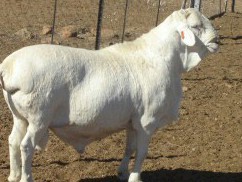 |
In 1906, Senator J. C. van Rooy, hailing from the Koppieskraal farm in the Bethulie district of South Africa, embarked on a pioneering venture aimed at cultivating a new breed of sheep optimized for the production of slaughter lamb. His vision for this breed was guided by three fundamental criteria:
To achieve these ambitious goals, Senator van Rooy initiated his breeding program by pairing a white "Blinkhaar Afrikaner" ram with eighty Rambouillet ewes. Through meticulous selective breeding and the application of inbreeding principles, he meticulously curated the genetic lineage of the progeny, striving for desired traits and characteristics.
As the breeding program progressed, a polled Wensleydale ram was later introduced to further refine the breed's conformational attributes. This strategic addition aimed to enhance the overall structure and physical appearance of the resulting offspring.
Today, the Van Rooy sheep breed continues to thrive primarily in arid regions, where its innate ability to survive and reproduce on natural grazing remains integral to its economic viability in meat production. The enduring legacy of Senator van Rooy's pioneering efforts lives on in this resilient and industrious breed, embodying the principles of strength, fertility, and superior conformation.